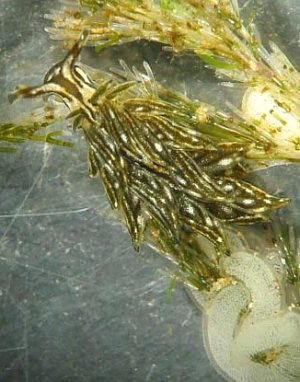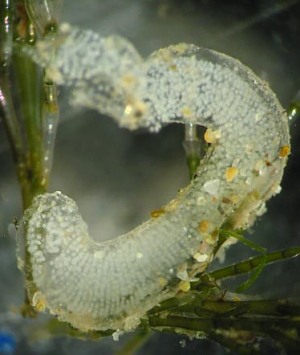Aplysiopsis cf. formosa from eastern Australia
November 26, 2002
From: Rachel Przeslawski


Hi Bill,
I collected these unknown egg masses on bryozoans off the Illawarra coast. [New South Wales, Australia]. When I got them back to the lab, I noticed 4 tiny, VERY well camouflaged aeolids(?) crawling among the bryozoan. I removed all the egg masses and kept the animals isolated overnight. The next morning there was another egg mass amongst the adults so this species definitely lays this egg mass.
Trouble is, I can't identify this species! The largest adults are 1cm long. They didn't shed their cerata until immersed in formalin. The egg masses have an egg-free rind with the eggs lined up in obvious circular bands. The eggs are 75um and the capsules are slightly larger at 100um.
Thanks for your help!
Rachel Przeslawski
rachelp@uow.edu.au
Przeslawski, R., 2002 (Nov 26) Aplysiopsis cf. formosa from eastern Australia. [Message in] Sea Slug Forum. Australian Museum, Sydney. Available from http://www.seaslugforum.net/find/8485Dear Rachel,
Thanks for this interesting find. Firstly the 'bryozoan' is an alga, although it does look quite like non-calcified bryozoans such as Zoobotryon and Amathia, and the slug is a sacoglossan, a group of herbivorous sea slugs, some of which look very similar to aeolid nudibranchs.
This species is quite common in southeastern Australia and has been identified with a European species Aplysiopsis formosa. The identification is probably correct, but it would be good to get the anatomy of the two compared. Also supporting the identification is its algal food. In Europe the species feeds on Cladophora prolifera, and it would appear that the southern Australian animals are also found on the same alga. I have asked Dr Allan Millar, Royal Botanic Gardens, Sydney to check the identification of the alga from the photos on the Forum. He agrees that Cladophora prolifera is the most likely name, but would like to see a sample before he can be 100% sure.
Thanks also for the information on its egg ribbon. You desribe the eggs being in 'circular bands'. If you look carefully I think you will find that the eggs are in a spiral chain, which is the normal arrangement in opisthobranchs.
best wishes,
Bill Rudman
Related messages
-
Re: Aplysiopsis cf. formosa from Victoria, Australia
From: Kathe R. Jensen, July 22, 2002 -
Identity of Aplysiopsis cf. formosa
From: Bill Rudman, July 22, 2002 -
Aplysiopsis cf. formosa from Victoria, Australia
From: Audrey Falconer, July 15, 2002 -
Egg ribbon of Aplysiopsis cf. formosa
From: Audrey Falconer, July 15, 2002 -
Aplysiopsis formosa? from S.E. Australia
From: John Chuk, June 21, 2002
